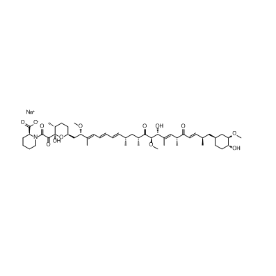| DC44967 |
RMC-5552
|
RMC-5552 is a potent and selective inhibitor of mTORC1. RMC-5552 inhibits phosphorylation of mTORC1 pS6K and p4EBP1 with IC50s of 0.14 nM and 0.48 nM, respectively. RMC-5552 has anti-cancer activity. |
| DC41010 |
PQR626
|
PQR626 is an orally available, and brain-penetrant mTOR inhibitor extracted from patent WO2017198346A1, compound example 44, has an IC50 of 5 nM for mTOR. PQR626 can be used for the research of neurological disorder. |
| DC9514 |
Deforolimus
|
Deforolimus(AP23573; MK-8669; Ridaforolimus) is a selective mTOR inhibitor with IC50 of 0.2 nM; while not classified as a prodrug, mTOR inhibition and FKBP12 binding is similar to rapamycin.
IC50 value: 0.2 nM [1]
Target: mTOR
in vitro: Treatment of HT |
| DC3118 |
Torin1
|
Torin1 is a potent inhibitor of mTOR with IC50 of 2-10 nM. |
| DC3117 |
Torin2
|
Torin 2 is a highly potent and selective mTOR inhibitor with IC50 of 0.25 nM, and also exhibits potent cellular activity against ATM/ATR/DNA-PK with EC50 of 28 nM, 35 nM and 118 nM, respectively. |
| DCAPI1488 |
Temsirolimus
|
Temsirolimus is an inhibitor of ribosomal protein S6 phosphorylation and inhibits cell growth and clonogenic survival of cells in a concentration-dependent manner. |
| DC11306 |
Secorapamycin A(Seco Rapamycin)
|
Seco-rapamycin(Secorapamycin A) is the first in vivo open-ring metabolite of rapamycin that does not affect mTOR.. |
| DC1048 |
Rapamycin (Sirolimus)
|
Rapamycin (Sirolimus, AY-22989, WY-090217) is a specific mTOR inhibitor with IC50 of ~0.1 nM. - |
| DC7482 |
Torkinib (PP242)
|
PP242 is a selective mTOR inhibitor with IC50 of 8 nM; targets both mTOR complexes with >10- and 100-fold selectivity for mTOR than PI3Kδ or PI3Kα/β/γ, respectively; also showed slightly weaker activity against BRD4 (Kd= 1.7 uM). |
| DC1501 |
Everolimus
|
Everolimus (RAD001) is an mTOR inhibitor of FKBP12 with IC50 of 1.6-2.4 nM. |






















